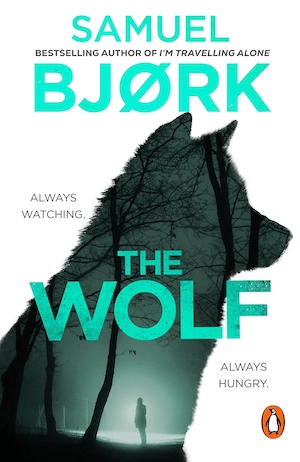
Translated by Charlotte Barslund — If you’ve been enjoying Samuel Bjork’s Munch and Krüger novels, The Wolf will take you back in time to their first case. If you’ve yet to discover them, then this prequel to I’m Travelling Alone is where their story begins.
Mia Krüger has been freshly recruited from the police academy by Holger Munch after a colleague praised her extraordinary analytical skills. The rest of his team aren’t convinced by the 21-year-old trainee, who seems to follow her gut rather than evidence. When the Oslo homicide unit is tasked with the murder of two 11-year-old boys, she has the chance to prove her worth.
Ruben Lundgren is discovered naked in a field with Tommy Sivertsen, meticulously arranged like a painting. It’s not the first time two boys have been found murdered in this manner. Another pair was found murdered in a field near Fagerhult, Sweden, eight years earlier. Oliver Hellberg was found naked and lying on his back, while Sven-Olof Jonsson was discovered a few metres away wearing only his underpants. A white hare was placed between them. The case remained unsolved, but the killer is now in neighbouring Norway to continue his killing spree.
No forensic evidence or leads to pursue at the crime scene – it seems almost too perfect, as though the murderer was well-versed in police pathology techniques. Mia might have an uncanny ability to find links that others miss, but her diagnostic skills still need work. Fortunately, the Swedish police send over Patrick Olsson, the profiler on the earlier case.
Munch and his team are under pressure. The unsolved Swedish case cost the justice minister his job and its senior investigating officer was replaced three times. The police were accused of leaking the murdered boy’s diary, which contained the words: “It’s a full moon tonight. I’m scared of The Wolf.” Hanne-Louise Dreyer, the newly appointed commissioner of the Oslo force, won’t let history repeat itself and threatens to close Munch’s unit after only a year in operation. To make matters worse, the media portray them as fools who have no idea what they’re doing.
Even though the books in the series can be classified as police procedurals, the psychological make-up of their characters is more important. Like in his other books, Bjork uses a sizeable cast of characters. Munch’s team includes the straightforward former lawyer Anette Goli, the antisocial Polish IT expert Anja Belichek, and the former boxer Karl Oxen, who has connections to criminal organisations in Eastern Norway. Each has a unique skill set and is given thorough characterisation in this prequel.
Aside from Munch and Krüger’s strong character development, the police detective Frederik Riis receives considerable attention. Bjork creates a character with high emotional intelligence who is frequently the first-in-line to deal with victims and get the right response from suspects. It’s why he clashes with the appropriately named Karl Oxen, a man who appears to be slow on the uptake and lacking in sympathy.
In Wolf we are shown the beginnings of Munch and Krüger’s unique dynamic, which will develop into a father-daughter-like relationship in later books. Despite her abrupt demeanour, absent-mindedness and bluntness, Munch has a fondness for Krüger. He realises she’s more vulnerable than she appears, which we observe as she worries about her twin sister, Sigrid, whom she hasn’t heard from in months. They shared a tumultuous childhood, born to a 16-year-old who didn’t want to raise them. Krüger feels a duty to look after and protect Sigrid, who is an addict, at all cost. Readers familiar with the series will already know how this pans out.
There is one storyline that may seem superfluous, and Bjork’s extensive plotting may be slightly too ambitious. In the end, he does connect this seemingly unimportant thread to the main plot but its inclusion results in a novel is overly bulky and could have been stronger without it.
Samuel Bjork’s stories are rarely predictable, and although events are unsettling, he never presents them in a way that is unduly graphic or gory in order to provoke a reaction from his readers. Like many of his fellow Scandinavian crime writers he addresses social issues prevalent in the region. The Norway depicted here is not the safe, pleasant country shown to the rest of the world. Oslo faces the same problems as other cities: child abuse, drug smuggling and all the crimes that are common worldwide.
Hitra, the next book in the series, was published in Norway in March 2023 and hopefully its translation will appear in 2024.
Also see The Killing Moon by Jo Nesbo.
Bantam
Print/Kindle/iBook
£10.99
CFL Rating: 4 Stars


Using our associate/affiliate links helps support the site.







